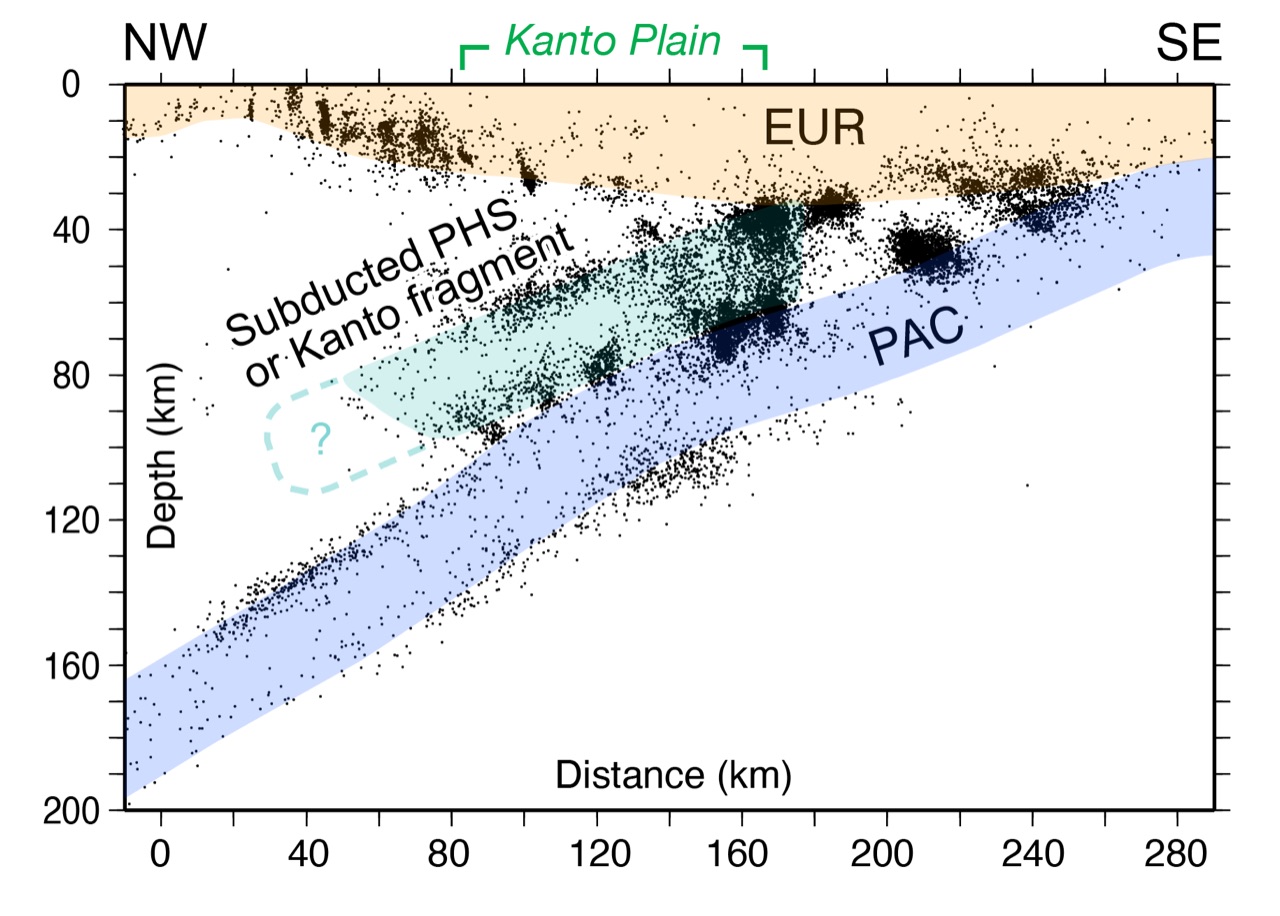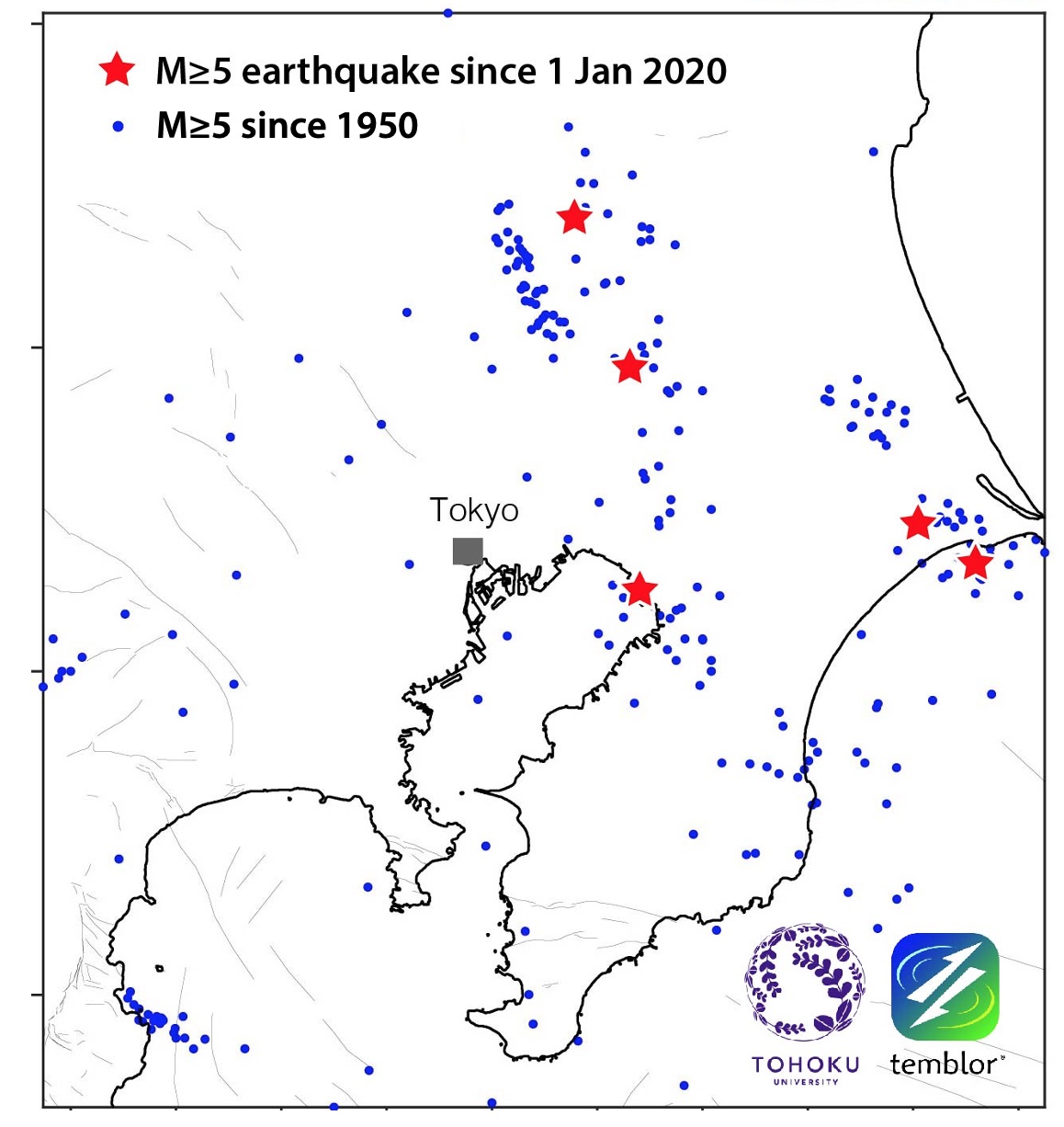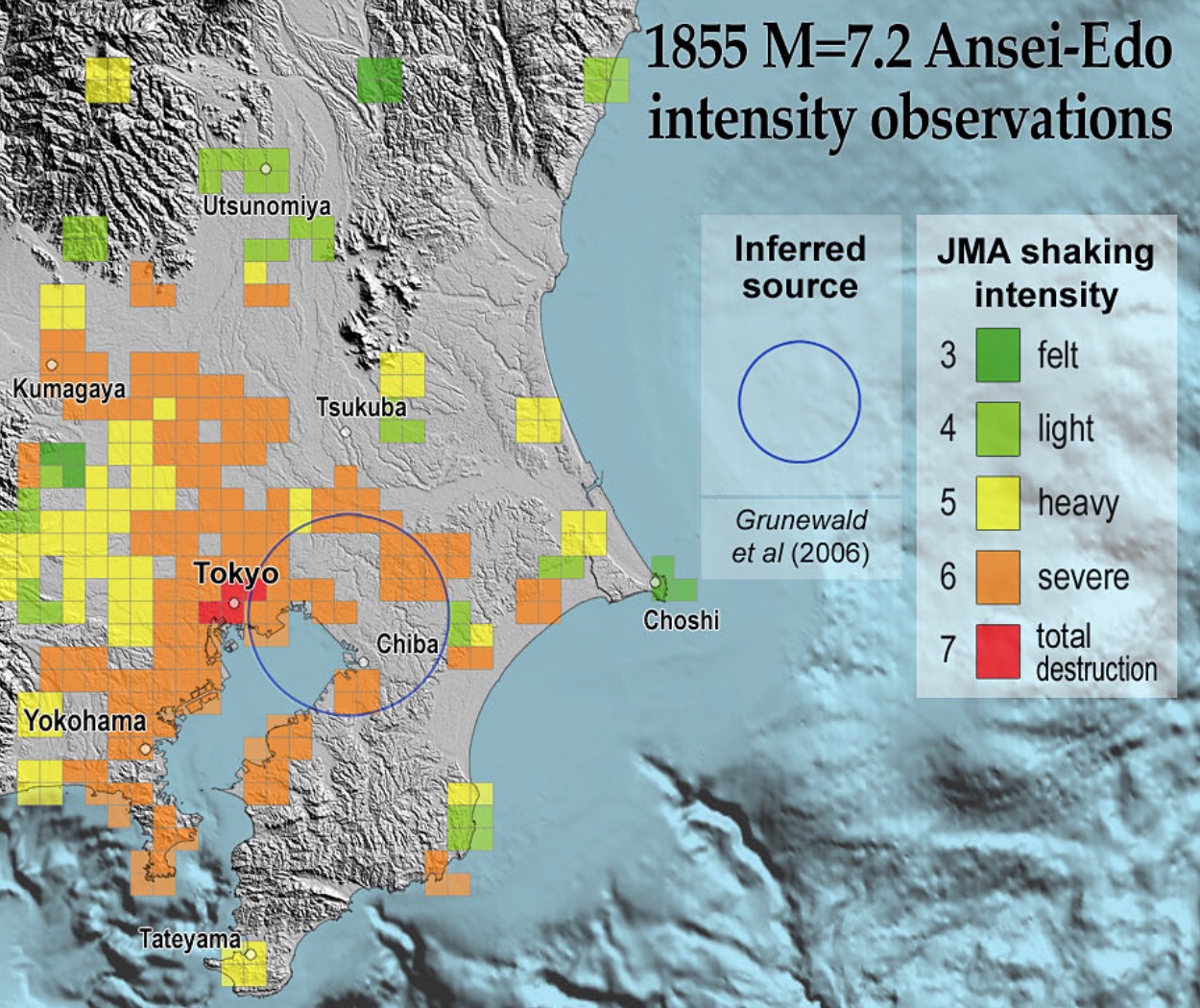Six magnitude-5.0+ shocks have struck greater Tokyo since April 1st, part of a larger swarm that extends north to Hokkaido, at a rate that is about three times higher than normal.
By Shinji Toda, Ph.D., International Research Institute for Disaster Science, Tohoku University, and Ross Stein, Ph.D., Temblor Inc.
Citation: Toda, S., Stein, R., 2020, Magnitude-5.9 quake is the latest and largest in Tokyo seismic swarm, Temblor, http://doi.org/10.32858/temblor.098

Tokyo’s seismic past and future
Earthquakes have long accosted the residents of Tokyo. Most devastating was the magnitude-7.9 1923 Kanto earthquake that killed ~105,000 people, rupturing the megathrust along the Sagami trough. An even larger event struck in 1703. Modern Tokyo and its suburbs are home to one-quarter of Japan’s 127 million population.
Tokyo is uniquely located where three tectonic plates converge, a setting known as a “triple-junction.” Both the Philippine Sea and Pacific plates are shoved, or subducted, beneath Tokyo, causing megathrust earthquakes on multiple plate interfaces, as well as shallow crustal quakes, and deep earthquakes within the subducting plates.

To evaluate the seismic hazard, the Japanese government has regularly updated their estimates of large earthquake probabilities since it launched the Headquarters of Earthquake Research Promotion in 1995. The last report announced that the 30-year probability of magnitude-6.7+ quakes for the Tokyo metropolitan area is ~70%.
The swarm so far
The recent magnitude-5.0+ earthquakes near metropolitan Tokyo emphasize the high risk of devastating earthquakes. From 1 April 2020 to 28 June, six earthquakes over magnitude-5.0 occurred within ~62 miles (100 kilometers) from the downtown Tokyo (lon. 139.750°/lat. 35.683°), which is two times higher than annual average rate of magnitude-5.0+ quakes since 1950. If this high rate remains, 14 quakes would strike Tokyo by the end of 2020.

The swarm quakes (red dots) in the above map are occurring in much the same location as past events (blue dots), indicating that the same faults that have slipped in the past are continuing to slip during the swarm. But now, these faults have been activated at a higher rate. We term the current rapid rate of earthquakes a ‘mild swarm,’ because it exceeds the range of natural fluctuation of rate rates. The only comparable period was the year after the 2011 magnitude-9.0 Tohoku earthquake, which transferred a large and sudden pulse of stress to the Kanto region (Ishibe et al., 2011; Toda and Stein, 2013).
Good news, bad news
We do not know why the rate of magnitude-5.0+ shocks is increased or whether the ongoing mild swarm could be precursory to a larger catastrophic event. However, the simplest and perhaps most prudent interpretation is that the higher the rate of moderate size quakes accompanies a higher probability of large ones. This assumes that the ratio of small to large quakes has not changed, which, as far as we can tell, is the case.
A counterargument to our interpretation signals a higher hazard (a higher chance of large events) would be that the swarm quakes indicate that ‘aseismic’ creep is also occurring, as has been recorded off the Boso Peninsula (Uchida and Matsuzawa, 2013). If the magnitude-5.0+ quakes accompany accelerated fault creep, that creep could reduce fault stress. This might then lower the probability of large earthquakes, as advocated by Sommerville (2014).

But there is a problem with this interpretation. Several of the swarm quakes struck at a location and depth similar to that of the magnitude~7.2 Ansei-Edo earthquake, which destroyed Edo (former Tokyo) in 1855. That means that the faults beneath Tokyo cannot exclusively creep accompanied by harmless magnitude-5.0 shocks; instead, those faults must also store enough stress to rupture in strong quakes, and so could again. Even if half the inferred slip rate of 1.7 inches per year (~40 millimeters per year) for the slab fragment with respect to the Pacific plate (Toda et al, 2008) is seismic, enough stress has accumulated since 1855 for 9.8 feet (3 meters) of slip, or enough for another deep magnitude-7.2 event.

Even in the time of COVID, we must prepare for quakes
Even while Japan continues to battle the coronavirus pandemic, as long as the swarm persists, the Japanese should make provisions for the possibility of large earthquakes. Given the great number of people in the Tokyo metropolitan area, we need to plan for shelters that are safe for both natural disasters and coronavirus infection, a daunting prospect.
Acknowledgements
We are grateful to the Willis Research Network of Willis Towers Watson for funding and scientific collaboration. We used the JMA and NIED hypocenter data to analyze seismicity with a software package ZMAP (Wiemer, 2001).
Further Reading
Grunewald, E., and R. S. Stein (2006), A new 1649-1884 catalog of destructive earthquakes near Tokyo and implications for the long-term seismic process, J. Geophys. Res., 111, doi:10.1029/2005JB004059.
Headquarters for Earthquake Research Promotion, 2014, Long-term seismic hazard estimates for the regions along the Sagami trough (updated), https://www.jishin.go.jp/main/chousa/kaikou_pdf/sagami_2.pdf. (in Japanese)
Ishibe, T., K. Shimazaki, K. Satake, and H. Tsuruoka, Change in seismicity beneath the Tokyo metropolitan area due to the 2011 off the Pacific coast of Tohoku Earthquake, Earth Planets Space, 63, 731–735, 201, doi:10.5047/eps.2011.06.001.
Sommerville, Paul (2014), A post-Tohoku earthquake review of earthquake probabilities in the Southern Kanto District, Japan, Geoscience Lett., 1, 10, doi.org/10.1186/2196-4092-1-10.
Toda, S., R. S. Stein, S. H. Kirby, and S. B. Bozkurt (2008), A slab fragment wedged under Tokyo and its tectonic and seismic implications, Nature Geoscience, 1, 771-776, doi:10.1038.ngeo318.
Toda, S. and R. S. Stein, 2013, The 2011 M=9.0 Tohoku oki earthquake more than doubled the probability of large shocks beneath Tokyo, Geophys. Res. Lett., 40, 2562-2566, doi.org/10.1002/grl.50524.
Uchida N, and T. Matsuzawa, 2013, Pre- and post-seismic slow slip surrounding the 2011 Tohoku-Oki earthquake rupture. Earth Planet Sci. Lett., 374, 81–91, doi: 10.1016/j.epsl.2013.05.021.
Wiemer, S., 2001, A software package to analyse seismicity: ZMAP, Seismol. Res. Lett. 72, 373– 382, doi.org/10.1785/gssrl.72.3.373.
- Earthquake science illuminates landslide behavior - June 13, 2025
- Destruction and Transformation: Lessons learned from the 2015 Gorkha, Nepal, earthquake - April 25, 2025
- Knock, knock, knocking on your door – the Julian earthquake in southern California issues reminder to be prepared - April 24, 2025
